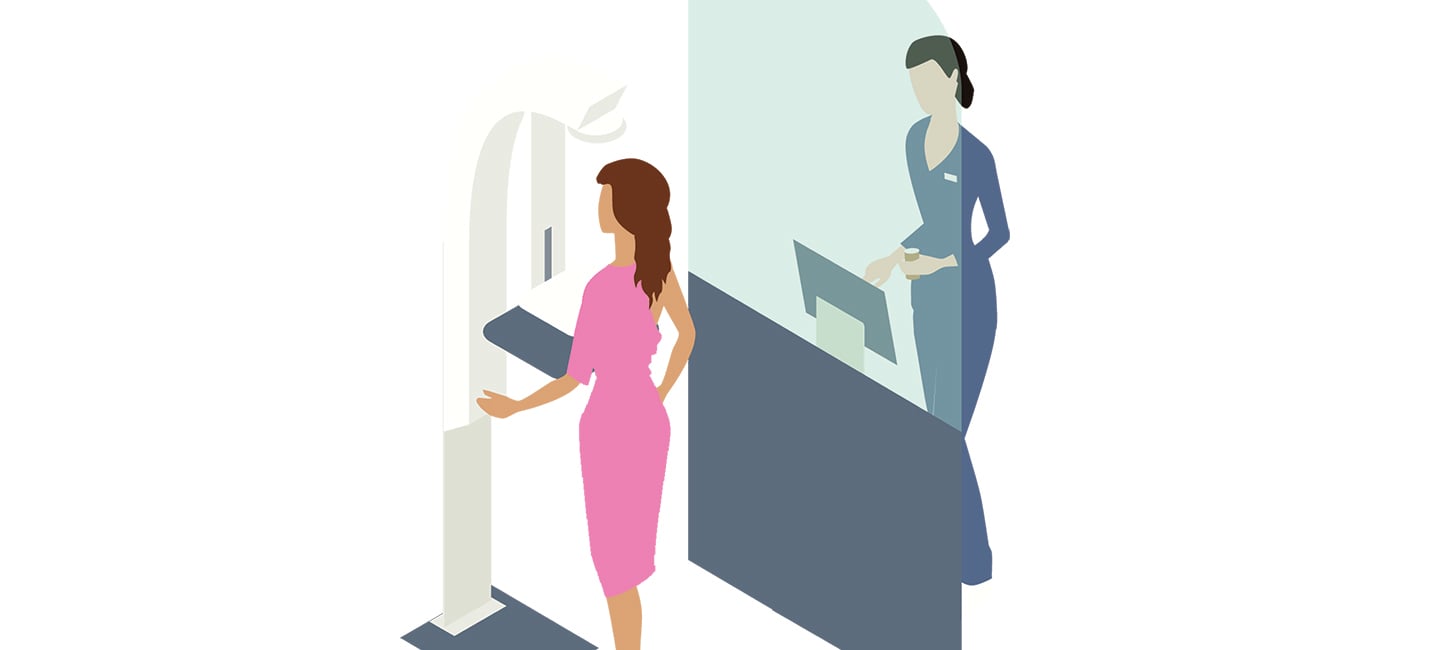What Is a Screening Mammogram?
Approximately 1 in 8 women will develop breast cancer during her lifetime. When it is found early, the prognosis is usually good with appropriate treatment. One of the first lines of defense in the fight against breast cancer is a screening mammogram. Here Moffitt Cancer Center experts share the answers to five common questions about breast cancer screenings:
1. What is a screening mammogram?
A screening mammogram is a preventive measure used to check for possible signs of breast cancer in women who do not have any noticeable symptoms. It is performed with a machine that is specifically designed to create detailed X-ray images of breast tissue using compression and small doses of ionizing radiation.
Mammograms often reveal solid tumors, fluid-filled cysts and fatty masses that are otherwise unnoticeable, as well as clusters of calcium called microcalcifications that may or may not be cancerous.
Moffitt also offers tomosynthesis (3D mammography) for screening and diagnostic purposes. A 3D mammogram uses a low-dose X-ray system and computer reconstructions to create 3D images of the breasts. It is digital and allows radiologists to review clearer, more precise images. With 2D imaging, certain areas of breast tissue can overlap on a flat image, creating the illusion that healthy tissue is abnormal. Anyone who is a candidate for 2D mammography can opt for 3D mammography, but it is recommended for:
- Men and women who have a family history of breast cancer
- Breast cancer survivors
- Individuals with particularly dense breast tissue
Insurance coverage for a 3D screening mammogram varies, so it’s best to check with your insurance provider.
To qualify for a screening mammogram, you must not have any symptoms with your breasts such as pain, a lump, a mass or nipple discharge.
2. Who should have a screening mammogram?
Physicians at Moffitt recommend women with an average risk of breast cancer begin screening at age 40. However, Moffitt does support your right to choose when to begin screening mammograms and how often you are screened as long as you are well informed about the benefits and drawbacks.
Keep in mind that the results of any mammogram alone cannot conclusively prove that a change in breast tissue is precancerous or cancerous. If a screening mammogram shows an abnormality, a physician will typically order additional testing, such as more mammogram images or images produced by breast ultrasound or magnetic resonance imaging (MRI). If further testing reveals a suspicious finding, a physician may recommend a biopsy to remove a small sample of cells from a suspicious area to check for the presence of cancer.
A prescription isn’t necessary for women 40 and older, but may be required for those under 40.
3. What can I expect?
Most mammograms take about 10 to 20 minutes. You’ll be asked to change into a wrap in a private dressing area. An X-ray technician will then position each of your breasts in a mammogram machine, one at a time. While your breast rests on a fixed plate for support, an upper plate will gently compress it, which will allow for a more detailed image. Meanwhile, the technician will use the machine to generate several images of your breast tissue. Some women find the compression to be a bit uncomfortable, but it typically does not hurt. If you’re concerned about discomfort, you can take an over-the-counter medication such as Tylenol an hour or two before your mammogram.
You should receive your mammogram results within a few days. Be sure to ask your provider how you will receive the results. Some providers will call regardless of whether the results are negative (normal) or positive (abnormal), while others only call if a mammogram reveals something out of the ordinary.
4. How do I prepare for a mammogram?
In order to have the best experience and get the most accurate results, Moffitt experts recommend:
- Scheduling an appointment during the week after your menstrual period to minimize discomfort
- Not wearing deodorant, antiperspirant, lotion, perfume and talcum powder to ensure the most accurate results
- Wearing a loose-fitting top that you can easily remove and put back on
- Not wearing earrings and necklaces (or wear jewelry that you can easily remove before the test)
Yes, Moffitt offers screening mammograms at the Richard M. Schulze Family Foundation Outpatient Center at McKinley Campus and Moffitt at International Plaza locations. We offer some same day and next day appointments.
If you have had previous imaging done outside of Moffitt, please bring a copy of the images on a CD for comparison.
To request a screening mammogram, call 1-888-663-3488.



